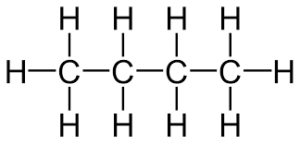Butane Formula
An easy understanding of the butane formula is very important. Especially when butane comes to use in the mechanism of products that many industries manufacture like fuel and refineries amongst others. It is an organic compound basically a colorless, odorless and highly flammable gas. It is in the alkane series. Sometimes it is referred to as n-butane where its branched-chain form is called isobutene. This topic will explain the butane formula with examples. Let us learn it!

Source: en.wikipedia.org
Butane Formula
What is Butane?
Butane, also known as n-butane, is a largely used organic compound gasoline blender and organic solvent. Butane occurs naturally like petroleum. It is available in the form of natural gas. By extracting the petroleum, it is started a process in which all the fractions and different products contained in the petroleum are separated into pure compounds. One of them is butane.
Formula and structure of Butane:
The butane chemical formula is:
It is a combination of two hydrocarbons i.e. alkanes where it is further composed of four carbon atoms, all are linked in a straight chain. It’s one molecule is the fourth simpler alkane, comprising of 4 carbon atom and 10 hydrogen atoms. Its expanded formula is,
Its geometry is tetrahedral with all the carbon atom having bonds of 109 degrees angle. Butane also has an isomer, known as methyl butane.
Butane has two structural, called normal butane, or unbranched butane, and isobutene, or i-butane. According to the IUPAC nomenclature system, these isomers are butane and 2-methylpropane.
As you know that isomers are molecules having the same molecular formula but different chemical structures. In this case, its two isomers will have these structural formulas
Properties:
Butane is a colorless gas with a density of 2.48 g/mL. Its melting point is -140 degree C and the boiling point is -1 degree C. It is soluble in water as well as in solvents. We can use it in a large number of reactions. For example, its combustion forms water and carbon dioxide. This reaction is very known and common for all the alkanes.
Its equation is 2
With limited oxygen, it will give CO instead of
Uses:
Butane is useful as a component of gasoline and fuel gas. Also, at low temperatures, we can use butane in the extraction of fragrance as well as in the production of some chemical compounds like butadiene. In the chemical industry, Butane is in use in the production of synthetic rubber and other compounds like plastic and sprays.
Solved Examples
Q.1: What are some negative health effects of Butane?
Solution: Health effects and safety hazards due to Butane is that it can cause damage to health. Butane gas inhalation may cause euphoria, asphyxia and in worst cases death also. Butane is also extremely flammable.
Q.2: Find out the molecular weight of Butane.
Solution: Butane chemical formula is,
So, its molecular weight will be,
=
=58.1222 gram per mole.
Therefore, the Molecular weight of Butane is 58.1222 gram per mole.